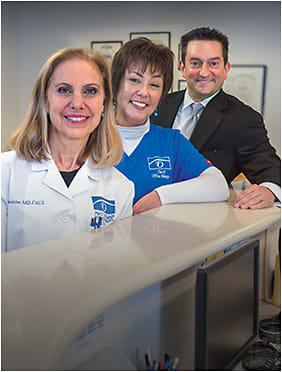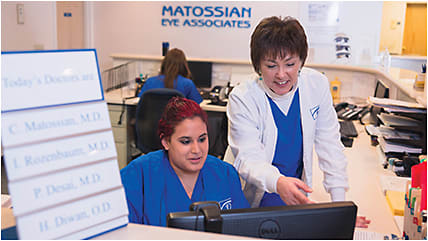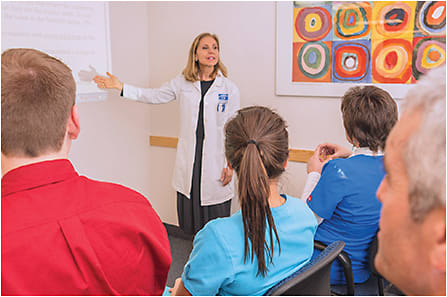Staff Development
A solid investment in staff training
How Matossian Eye Associates develops well-respected staff members who excel in patient care
BY ROBERT CALANDRA
Over the past 28 years, Cynthia Matossian, MD, FACS, has earned the reputation as an ophthalmologist passionate about her profession and patients.
“I was always in pursuit of looking at my practice from the patient’s point of view,” says Dr. Matossian, founder of Matossian Eye Associates (MEA), with offices located in Doylestown, PA, and Hopewell and Hamilton, NJ. “My goal is to make the patient experience better and more positive.”
That means providing the best possible clinical outcome, efficient operations and service levels that delight patients. To meet this goal, Dr. Matossian relies on finding and training employees who want to grow with the practice.
“We work very hard at building a team culture through interdependence and meetings,” Dr. Matossian says. “Our staff is very well respected. Their tasks continue to evolve so they are not stuck in a rut.”
MEA employees, from the newest front desk member to the technicians and scribes, receive hours of detailed training before taking full responsibility for their job. The result: confident staff members who treat patients well and are up-to-date on the latest technology and equipment.

From left: Cynthia Matossian, MD, FACS, Practice founder; Cheryl Price, office manager; Brad Botelho, practice administratorPHOTOGRAPHY BY JSAYCREATIVE PHOTOGRAPHY
“It enhances the patient’s visit and gets to a direct diagnosis,” Dr. Matossian says of the practice’s training regimen.
Hiring for the best outcome
Providing the “best possible outcome” starts with the hiring process. MEA prefers applicants who have a solid work record — preferably in a service industry — and some college experience. Brad Botelho, MEA’s practice administrator, looks for energetic, extroverted, inquisitive people who want to grow professionally.
“It’s a fantastic company and practice for growth,” Mr. Botelho says. “There is ample training at all levels.”
One of the critical steps in training at MEA is for new employees to learn by shadowing senior staff members. As the new employee masters the tasks, the roles switch, and the senior staff member observes the new employee performing tasks.
At the front desk
Through shadowing, the new employee observes, for example, that the role of the front desk staff member goes well beyond patient check-in and check-out. Dr. Matossian describes the front desk staff as the practice’s “key business developers” who are responsible for turning prospective phone calls into patients. Training at MEA comes in small, manageable segments but is hands on. All front desk staff (who wear royal blue scrubs so patients can easily identify them) begin by learning how to properly greet arriving patients and to answer the phone.

At the front desk, Cheryl Price (standing) and Caroline Muller discuss improvements to check-in. MEA employees receive hours of detailed training.
New employees observe a head front-desk person for at least a week where they learn about appointments, insurance and payments. They also observe medical procedures and diagnostic tests firsthand so that they can explain these to callers.
During this time, new employees are expected to take notes. Once they are comfortable with what they’ve learned, new front-desk employees will confirm upcoming appointments and then progress to patient check-in and check-out.

|
“My goal is to make the patient experience better and more positive. |
Even though the new staff member works with a senior staffer, Cheryl Price, MEA’s office manager, keeps an eye on their progress. Ms. Price listens and observes as new front desk staff members field calls and questions. And she expects them to pepper her with their own questions.
“People have to understand their job 100%,” Ms. Price says. “So they should want clarification as to why things are done a certain way and ask for more details.”
Tech training
Because there are too few trained ophthalmic assistants in the workforce, the burden of training new technicians usually falls on the practice. MEA brings on new technicians about three to four times a year. (All technicians wear turquoise scrubs for easy identification.) After a formal orientation period, new techs train five days a week. During this phase of training, the new tech observes and asks questions. After one or two weeks, they begin mastering data entry into the electronic medical records (EMR) system.
Observation and asking questions are the keys to training at MEA. Pictured here are technicians Joan Micucci, COMT (right) and Hannah Woytowicz with public relations assistant Daniel Rue.
Next, they perform basic tests, such as visual fields. The practice gradually increases the new techs’ responsibilities through one-on-one practice sessions. All their work is double-checked by their assigned mentors. Training on more complex diagnostic equipment can occur over months. Technicians also role-play during their training to help them understand visits from the patient’s viewpoint.
In the next step of training, the technician learns how to screen patients. This is followed by a minimum three-month rotation in the subspecialties, including cataracts, glaucoma, oculoplastics, contact lenses and retina. During these rotations, the techs learn how to set up procedures, such as retinal injections.
During their first 90 days, all new techs are required to complete a series of training modules provided by BSM Consulting. The training sessions are completed after work hours and continue until the technician passes each module error free.
The scribe opportunity
After working as a technician for at least one year, the tech is given the opportunity to become a scribe. At Matossian Eye Associates, scribes perform the diagnostic tests, ask the patients follow-up questions and then scribe during the patient-physician encounter. “Both roles provide high levels of efficiency that serve the patient, physician and practice,” says Dr. Matossian.

|
“It is a fantastic company and practice for growth. There is ample training at all levels. |
The training, which takes approximately two months, is demanding — ultimately, not every tech becomes a scribe. Accuracy is a must. The scribe is expected to act as the “physician’s recorder,” entering every word into the patient medical record.
The training continues
Training continues each week through mandatory meetings. These follow a formal agenda and cover a variety of topics, including terminology, insurance issues, HIPAA guidelines and customer service advice. Staff members may be called upon to answer questions. Staff discuss specific issues that occurred during the previous week along with ways to answer or resolve them.
|
“People have to understand their job 100%. |
The staff also has input into how the practice is running. Employees can air their concerns through an anonymous survey or each week at staff-only meetings. Ms. Price says people are more willing to speak openly and air their concerns without a doctor in the house.
In addition, MEA encourages staff to become certified ophthalmic assistants by officially sponsoring them for certification and providing after-hours study sessions. The practice also pays for local courses, when available.

An integral part of training at MEA are the weekly meetings, which cover a variety of topics, as well as specific issues that occurred in practice during the previous week.
Specific training tips may arise as a result of patient satisfaction surveys. MEA has developed its own 11-question survey that polls patients on each step of their appointment. Each week the management team reviews and analyzes those surveys and tries to address patient issues. If there is a negative review, the appropriate manager takes it to the employee responsible.
An evolving practice culture
Matossian Eye Associates’ culture continues to grow and evolve. Dr. Matossian is currently working on having everyone on staff certified in their business specialty. Front desk personnel will become certified patient specialists, while techs will be known as “ophthalmic assistants.” Scribes will carry the imprimatur of “government medical scribe specialist,” and billing employees will be certified in ophthalmology billing and coding. These certifications ensure that each staff member follows uniform, best-practice standards.
It’s not all training and surveys at Matossian Eye. Every quarter employees leave the office to let their hair down. The demanding training regimens are balanced with team-building exercises and activities, such as attending Trenton Thunder baseball games, the AA minor league Yankees team.
Continuous improvement
Dr. Matossian continues to look for ways to grow her business and hone her employees’ skills. She spends an average of 15 hours a week away from the office reading patient surveys and employee feedback searching for new ways to improve the practice.
“I read up on whatever areas we can improve on, or I ask my colleagues or an industry representative how to improve,” she says. “We do the best we possibly can to ensure the patient receives the best possible experience with the best surgical and the best medical outcome.” OP
|
Robert Calandra is an award-winning journalist who writes about health and medicine. He can be contacted at rotoca@verizon.net. |








